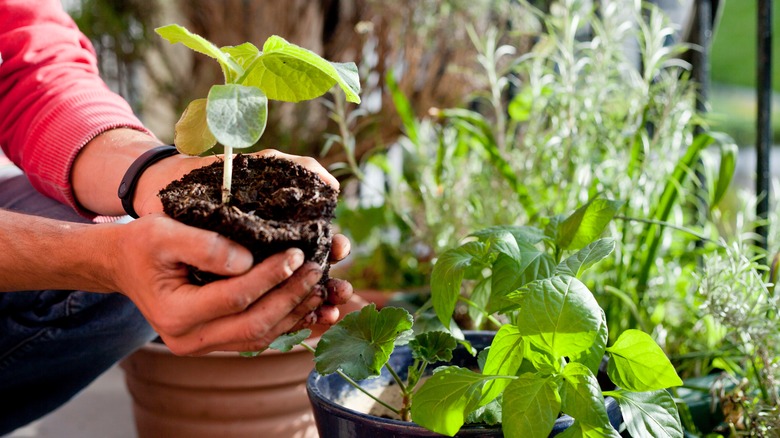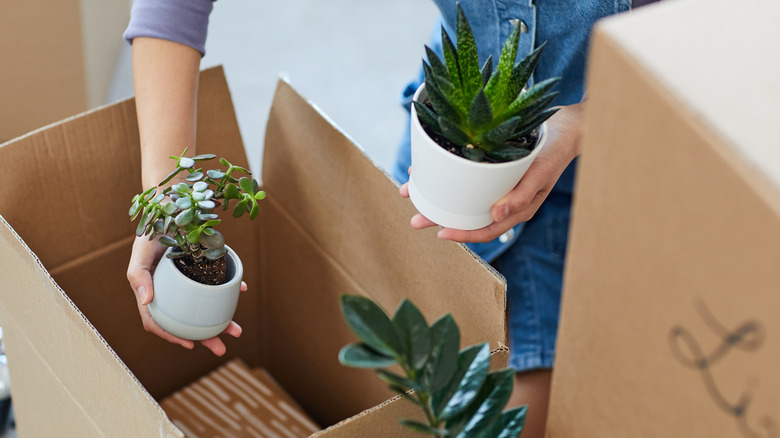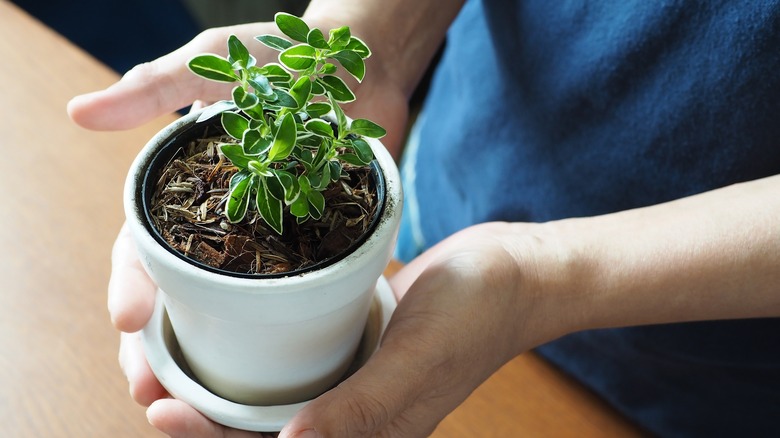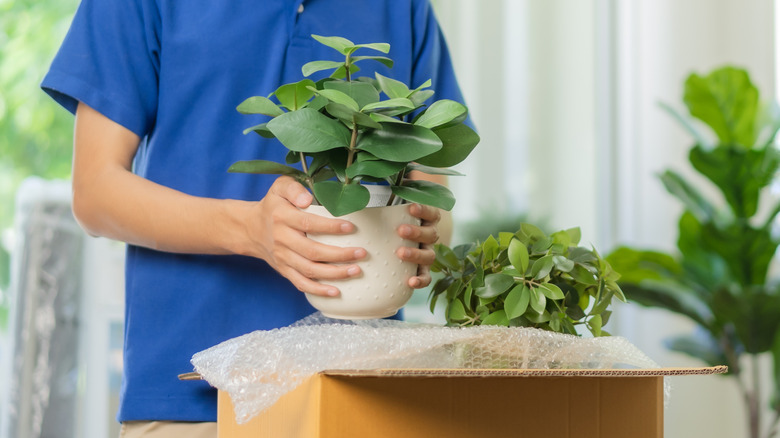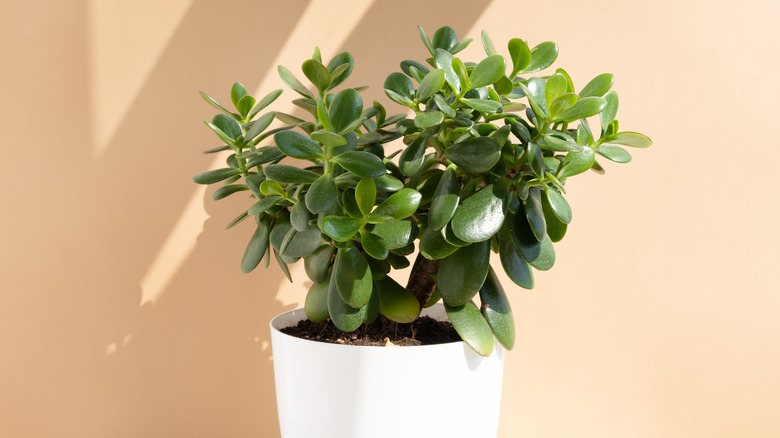5 Ways To Safely Pack Your Plants On Moving Day
Whether you are moving across the country or just upgrading to a bigger house down the road, the process of transitioning all your things from one home to another can be a stressful and exhausting process. Most of your possessions will need to be safely packaged into boxes, which can then be transported with a moving truck or van. Unfortunately, this may not work for all of the possessions you have around your home.
Bloom and Grow claims that when it comes to moving with plants, you cannot simply place them in a box like the rest of your belongings. To safely transport your house plants from one home to another, there are many precautions and preparations that make this task taunting to avid plant parents. You don't want to risk any harm to your plants, but you also can't bear to leave them behind. Although it may take some work, there are a variety of ways you can take your house plants with you wherever you may move to. To learn more about how to safely transport your house plants during your next move or relocation, we'll walk you through five ways you can safely prepare and pack your plants for a safe moving day.
Before the move
Before even considering the packaging and transportation process, it's important to first prepare your plants for their major transition. Move Buddha explains that you must give your plants time to prepare and adjust before even starting the moving process. For the best results, it is highly recommended to start preparing them at least three weeks before your moving day.
To start the preparation process, you need to transition your plants into their moving pots, which should be lightweight plastic pots filled with sterilized soil. Their original pots can then be safely packaged with the rest of your possessions. After a week of adjusting to their new potted environment, you need to give your plants a thorough pruning. This means getting rid of dead parts of the plant and trimming the foliage to a minimal amount to promote health during their stressful transition. Three days before moving day, it is also advised to thoroughly water each of your plants. Most house plants only need to be watered once a week; therefore, if you water them three days before your moving day, they won't be wet during the transportation process and won't need to be watered during that period either. Finally, if you are moving either out of your current state or even out of your current country, it's important you don't bring any pests along with your plants. Simply place flee collars around the pots of your plants to keep them pest free as they transition over to your new home.
Driving
Moving day can be stressful enough without having to think about your beloved plants. So, to give you peace of mind, Bloom and Grow recommends transporting your plants in the car you will be driving in, specifically in the passenger area of your vehicle. This allows you to keep a good eye on them and keep physical control of their environment as you travel. If the journey happens to be an overnight trip, it also warned to never leave your plants in the car while you rest for the night. Take them into the hotel or motel with you until you are ready to resume the journey to your new home.
To prepare your plants for traveling in your car, Atlas suggests wrapping your plants in either a bedsheet or tissue paper to avoid branches from breaking throughout the entire moving process. It is also advised to place your plants inside boxes with paper stuffed between each pot to ensure they do not tip or collide with each other during the drive. If you need to put a lid on your plant boxes, ensure they have holes that provide your plants with proper circulation, and you must label boxes clearly to prevent them from accidentally being packed into the back of your moving car or van with the rest of your possessions.
Flying
Sometimes driving to your new home is not possible. If this is the case, you also have the option of bringing some of your most cherished plants on the plane, train, or even the boat with you. Although packing your planting into your luggage may sound difficult and dangerous for your plant, Bloom and Grow walks its viewers through an easy way you can make it happen.
Start by placing a damp paper towel over your plant's soil to help it retain moisture. Then, use a fitting plastic bag and place the pot of the plant inside the bag. Ensure the bag is only surrounding the potted area of the plant before securing it with a rubber band. Then, gently wrap the foliage of your plant with newspaper. After your plant is properly prepared, you can gently fit it into your carry-on bag. While you are traveling, be very careful with this bag. The plant should always remain in its standing position; therefore, the bag should never be placed anywhere sideways or up-side-down. Also, before traveling out of your state or even out of your country, ensure the plant is safe and legal to be brought to the place you are going.
Shipping
When taking your plants with you isn't an option, you can also ship your plant to your new home through the mail. Shipping your plants is also a great way to eliminate the hassle and stress of transporting your plants on your own. Instead, you can safely package them up and let your choice of mail carrier deliver them to your new home. Despite the simplicity of this technique, it is still a stressful process for your plants to go through; however, with the right packaging technique, you can easily give your plant an easy and stressless transition.
According to Plant Man P, to package your plants for shipping, you need to start by removing them from the current pot they are in. During this process, you should also gently separate as much soil from the plant's roots as you can. When your plant has been properly prepared, you should wrap its roots in a damp, moss-covered paper towel and seal it onto the plant with plastic wrap. It may take a couple of layers of plastic wrap to completely seal the paper towel onto the plant. Once it is sealed, use some masking tape to secure the contraption. When you are finished, wrap the entire plant in either bubble wrap, or a couple of layers of paper, before packing it into your shipping container. Be sure the container is properly cushioned with plenty of bubble wrap or packing paper to keep it from shifting during the shipment. Ship it as soon as possible!
After arrival
After you have arrived at your new home, it's important that you tend to your plants right away. Plants do not like being transported due to the massive amount of stress it puts on them; therefore, it's imperative that you try to relieve that stress and set them up for a proper recovery quickly.
Well + Good states that as soon as you bring your plants inside your new home, you should immediately open the box or remove the lid or cover from whatever container they are inside and expose them to sunlight once again. Next, scope out your new home and find the perfect place for each of your plants. For example, if you have a sun-loving plant, ensure it is placed in a sunny spot within your home. If you come across any of your plants that have wilted during the moving process, start by removing any flowers from the plant to help it regain some of its lost energy. Giving your plants fertilizer or any sort of extra nutrition is another great way to improve their condition and assist them in their recovery process. As you monitor your plants during their recovery process, be patient with your plants and give them time.

